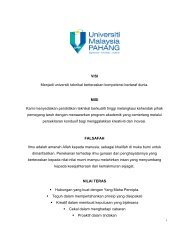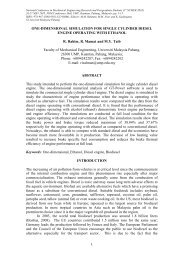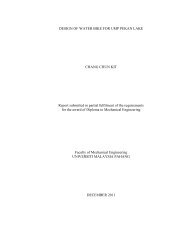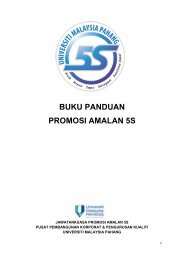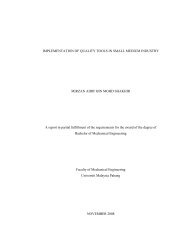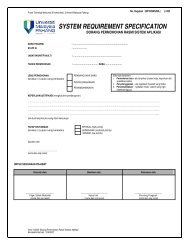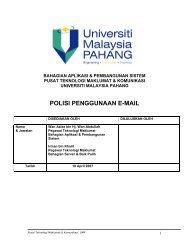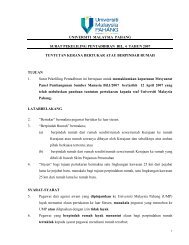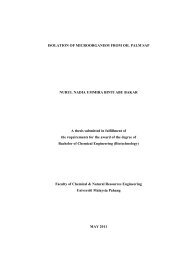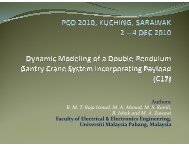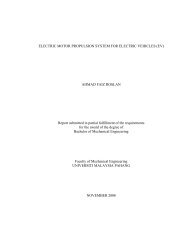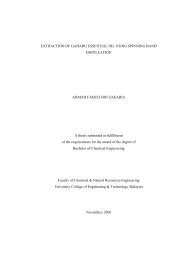DEVELOPMENT AND CHARACTERIZATION OF SULFONATED ...
DEVELOPMENT AND CHARACTERIZATION OF SULFONATED ...
DEVELOPMENT AND CHARACTERIZATION OF SULFONATED ...
Create successful ePaper yourself
Turn your PDF publications into a flip-book with our unique Google optimized e-Paper software.
<strong>DEVELOPMENT</strong> <strong>AND</strong> <strong>CHARACTERIZATION</strong> <strong>OF</strong> <strong>SULFONATED</strong>POLYSULFONE FOR MEMBRANE FUEL CELLWAN MUHD NADZMI WAN YAAKUBA thesis submitted in fulfillment for the award of the Degree of Bachelor inChemical Engineering (Gas Technology)Faculty of Chemical and Natural Resources EngineeringUniversiti Malaysia PahangAPRIL 2009
iiI declare that this thesis entitled “Development and characterization of sulfonatedpolysulfone for membrane fuel cell” is the result of my own research except as citedin the references. The thesis has not been accepted for any degree and is notconcurrently submitted in candidature of any other degree.Signature : ....................................................Name : Wan Muhd Nadzmi Wan YaakubDate : 30 APRIL 2009
Dedicated, in thankful appreciation for support,encouragement and understandingto my beloved family and friends.iii
ivACNOWLEDGEMENTIn the name of Allah S.W.T. the most gracious and most merciful, Lord of theuniverse, with His permission Alhamdullilah the study has been completed. Praise toProphet Muhammad S.A.W., His companions and to those on the path as what Hepreached upon, might Allah Almighty keep us His blessing and tenders.First of all, I would like to express my gratitude to my research supervisor, PnRosmawati Binti Naim for her valuable guidance, advices, efforts, supervision andenthusiasm given throughout for the progress of this research. Although she alwaysbusy with hers work, she still can spend the time in completing this research.I owe tremendous appreciation to my parents, Wan Yaakub Wan AbdRahman and Rohani Abd Latiff for their support and motivation during the toughtime throughout the duration of this study I also want to thanks to Mohd NorazamBin Mad Aris and Mohd Shamim Waliyuddin for their kindness to help inaccomplished this projecttime.Thank you so much for all. May Allah S.W.T. the Almighty be with us all the
vABSTARCTSulfonation process was used to produce ion exchange polymer from acommercial polysulfone .Membranes obtained from the sulfonated polysulfone(SPSU) are potential substitutes for perflourosulfonic acid membrane (Nafion TM )used now in polymer electrolyte fuel cell due to its high cost to produce, needs ofhigh pressure and high hydration level to operate effectively. Sulfonations wereachieved by varying the degree of sulfonation (DS) in reaction time.Characterizations of different degree of sufonated polysulfone membranes wereconducted through elemental analysistal, Fourier Transform Infared (FTIR) andswelling test. Fourier Transform Infared (FTIR) were used to confirm the presence ofsulfonic group in the polymer after sulfonation process and it was clearly confirmedby the SO 3 stretching bond at frequency 1020 cm -1 to 1035cm -1 . The hydration levelsof membrane were measured via swelling test. Result showed the percentages ofwater and methanol uptake broadening as the degree of sulfonation increased.
viABSTRAKProses pensulfonan telah dikaji untuk menghasilkan polimer kapasitipenukaran ion dari polimer polisulfona . Membran yang terhasil daripadapengsulfonan polisulfona (SPSU) adalah berpotensi untuk menggantikan membranberasid (Nafion TM ) yang buat masa sekarang di guna pakai di dalam sel keringberpolimer elektrolit adalah kerana harganya yang mahal untuk dihasilkan,memerlukan tekanan yang tinggi dan memerlukan kandungan cecair yang tinggiuntuk beroperasi secara efektif. Proses pensulfonan dijalankan denganmempelbagaikan darjah pengsulfonan dalam masa reaksi yang berbeza. Karateristikyang berbeza oleh darjah pengsulfonan membran yang diperolehi melalui analisiselemen Spekstrokopi Infra-Merah Penukaran Fourier (FTIR). Infra-Merah PenukaranFourier digunakan untuk mengesan kumpulan berfungsi sulfonik ke dalam strukturpolimer setelah proses pengsulfonan dan keputusan menunjukkan dengan jelaskehadiran kumpulan berfungsi asid sulfonik (SO 3 ) pada frekuensi 1020cm -1 hingga1035cm -1 . Keberaliran membran dikaji dengan menggunakan kaedah keberaliran.Kajian mendapati semakin tinggi darjah pengsulfonan semakin tinggi peratusankeupayaan membran untuk meresap air dan methanol.
viiTABLE <strong>OF</strong> CONTENTSCHAPTER TITLE PAGEDECLARATIONDEDICATIONACKNOWLEDGEMENTABSTRACTABSTRAKTABLE <strong>OF</strong> CONTENTLIST <strong>OF</strong> TABLESLIST <strong>OF</strong> FIGURESLIST <strong>OF</strong> APPENDICESiiiiiivvviviixiixivxvi1 INTRODUCTION1.1 Research Background 11.2 Problem Statement 31.3 Objectives of Research 31.4 Scope of Research 32 LITERATURE REVIEW2.1 Membrane Review 42.1.1 Definition of Membrane 42.1.2 Type of Membrane 52.1.2.1 Microporous Membrane 52.1.2.2 Homogenous Membrane 52.1.2.3 Asymetric Membrane 52.1.2.4 Electrically Charge Membrane 6
xGANTT CHART 46Appendices 1-8 47-51
xiLIST <strong>OF</strong> TABLETABLE NO. TILTLE PAGE2.1 The Characteristics of Membranes 93.1 Polysulfone Properties 273.2 Properties of Sulfuric Acid 283.3 Properties of Sodium Methoxide 293.3 Properties of Dimethylforamide 294.1 Sulfonation Process Condition 334.2 Atomic Composition of CHNS 344.3 Sulfur and Carbon Percentages in Samples 354.4 Degree of Sulfonation 364.5 Wavelentgh of Membrane Samples 384.6 Water.Uptake Percentages 394.7 Methanol Uptake Percentages 40
xiiLIST <strong>OF</strong> FIGUREFIGURE NO TILTLE PAGE2.1 Basic Concept of PEM Fuel cell 122.2 Fuel Cell 132.3 Classification of Membrane Material 232.4 The Structure of Nafion TM 232.5 Sulfonation Process of Polysulfone 253.1 Polysulfone Structure 263.2 Electrophilic Substitution by Sulfuric Acid 273.3 Factor Influencing the CharacteristicSulfonated Membrane 293.4 Experimental Stages 303.5 Sulfonation Process and PolymerMaking Apparatus 313.6 Casting Knife 314.1 Result FTIR for PSU 374.2 Result FTIR for SPSU6 374.3 Result FTIR for SPSU16 384.4 Result FTIR for SPSU26 38
xiiiLIST <strong>OF</strong> APPENDICESAPPENDIX NO TILTLE PAGE1 Polymer Dissolved Process 472 Sulfonation Process 483 Sulfonated Polysulfone Particle 494 Sulfonated Polysulfone Dissolved Process 495 Degasses Process 506 Sulfonated Polysulfone Solution After DegassesProcess Structure 507 Casting Apparatus 518 Membrane Produced 51
CHAPTER 1INTRODUCTION1.1 Research BackgroundNow days the world is actively pushing for cleaner energy technologies. Thisis because of the public concern about the environments condition. Ozone layer hasrapidly become thinner day by day because of the dangerous toxic release during theenergy conversion. This has prompted research for clean and efficient alternativesfor power generation and one of the most attractive alternatives is electrochemicalfuel cell technology. Fuel cells have several advantages that make them attractivepower sources for high thermal efficiency, extremely low or zero emissions, and lownoise and vibration in comparison to conventional power trains.Fuel cell used hydrogen and oxygen to produce electricity, water and heat asby-product. As long as fuel is supplied the fuel cell will continue to generatepower. . In principle, a fuel cell operates like a battery. Unlike a battery, a fuel celldoes not run down or require recharging.The awareness about environment and fossil fuel limited resource in thiscemtury had led many countries especially United State of America, UnitedKingdom Japan and Canada to give more attention in development andimplementation of this fuel cell to multiple field mainly transportation, stationarypower, and micro electronic devices. These also enhanced big company intransportation business such as Daimler Chrysler, Ford, Ballard, Honda and Toyotato give more work in this type of energy conversion device. Several experiments
2have been conducted in order to verify the performance and upgrade the current fuelcell system. Meanwhile for high capacity power generation, Solid Oxide Fuel Cell.(S<strong>OF</strong>C) has made their remarked as a higher performance and efficiency forhigh capacity power supply and distributed generation compared to other type of fuelcell.The common membranes used in fuel cell application are Proton ExchangeMembrane (PEM) Fuel Cell has gain more attention due to its ability in high powerdensity and high flexibility. Scientists and engineers are carrying out specificresearch into the structural design, thermodynamics, and heat transfer processes ofone class of this PEM fuel cell. Commercially, Nafion TM membrane manufactured byDuPont de Nemours has been used as the polymer electrolyte membrane material forfuel cell. This was due to its outstanding chemical and mechanical stability whichcomposed of perflourinated carbon chains and sulfuric acid group at the end of sidechains. However this type of membrane sensitive to contaminants and methanolcannot operate above 80’C its more expensive cost due the complicated productionprocess (Zydney et al, 1996).In oder to get the most efficient system of PEMFC, the membrane developneed to have a good and stable membrane operating at desired temperature andpressure. The need of developing membrane that satisfies this condition with theminimum cost of production and maintenance are recommended.
31.2 Problem StatementCurrently, common membrane for Proton Exchange Membrane Fuel Cell(PEMFC) is perflourosulfonic acid called Nafion TM . Until now Nafion remains asstandard for industry but it was very expensive to produce and require heat, highpressure and high level hydration in oder to perfom effectively. Thus the mainresearch in membrane fuel cell is to develop cost-effective material and membranethat can operate at low pressure and at high temperature.1.3 Objective of ResearchThe objective of this research is to develop and characterize the sulfonatedpolysulfone membrane for Proton Exchange Membrane Fuel Cell (PEMFC)application.1.4 Scope of the Researchbeen drawnIn order to accomplish the set objectives, the following scope of works has.i. Development and fabrication the sulfonated polysulfone as a membranefor fuel cell.ii.iii.Study the effect of reaction time, for various degree of sulfonation.Study the physical and chemical characteristic of sulfonated polysulfonemembrane using FTIR, Elemental Analysis, and water swelling
CHAPTER IILITERATURE REVIEW2.1 Membrane ReviewA membrane is a layer of material which serves as a selective barrierbetween two phases and remains impermeable to specific particles, molecules, orsubstances when exposed to the action of a driving force. Some components areallowed passage by the membrane into a permeate stream, whereas others areretained by it and accumulate in the retentate stream (Larmine et al, 2000).2.1.1 Definition of MembraneMembrane can be defined essentially as a barrier, which separates two phasesand restricts transport of various chemicals in a selective manner. A membrane canbe homogenous or heterogeneous, symmetric or asymmetric in structure, solid orliquid can carry a positive or negative charge or be neutral or bipolar. Transportthrough a membrane can be affected by convection or by diffusion of individualmolecules, induced by an electric field or concentration, pressure or temperaturegradient. The membrane thickness may vary from as small as 100 µicron to severalmms (Nunes et al, 2003).
52.1.2 Type of MembraneThere are several types of membrane but most of them still have the samebasic principle and structure.2.1.2.1 Microporous MembranesMembrane behaves almost like a fiber filter and separates by a sievingmechanism determined by the pore diameter and particle size. Materials such asceramics, graphite, metal oxide and polymers are used in making such membranes(Scott et al, 1998).2.1.2.2 Homogeneous MembranesThis type of membrane is a dense film through which a mixture of moleculesis transported by pressure, concentration or electrical potential gradient. Using thesemembranes, chemical species of similar size and diffusivity can be depends on theirconcentration (Scott et al, 1998]).2.1.2.3 Asymmetric MembranesAn asymmetric membrane comprises a very thin (0.1-1.0 micron) skin layeron a highly porous (100-200 microns) thick substructure. The thin skin acts as theselective membrane. Its separation characteristics are determined by the nature ofmembrane material or pore size, and the mass transport rate is determined mainly bythe skin thickness. Porous sub-layer acts as a support for the thin, fragile skin and haslittle effect on the separation characteristics (Scott et al, 1998)
62.1.2.4Electrically.Charged.MembranesThese are necessarily ion-exchange membranes consisting of highly swollengels carrying fixed positive or negative charges. These are mainly used in the electrodialysis(Nunes et al, 2003).2.2 Membrane Separation Process2.2.1 Separation ProcessIn chemistry and chemical engineering, a separation process is used totransform a mixture of substances into two or more distinct products. The separatedproducts could differ in chemical properties or some physical property, such as size,or crystal modification or other. Barring a few exceptions, almost every element orcompound is found naturally in an impure state such as a mixture of two or moresubstances. Many times the need to separate it into its individual components arises(Baker et al, 2000).A membrane separation system separates an influent stream into two effluentstreams known as the permeate and the concentrate. The permeate is the portion ofthe fluid that has passed through the semi-permeable membrane. Whereas theconcentrate stream contains the constituents that have been rejected by themembrane. The proper choice of a membrane should he determined by the specificapplication objective: particulate or dissolved solids removal, hardness reduction orultra pure water production, removal of specific gases/chemicals etc. The end-usemay also dictate selection of membranes for industries such as potable water, effluenttreatment, desalination or water supply for electronics or pharmaceuticalmanufacturing (Baker et al, 2000).
72.2.2 Type of Membrane Separation ProcessThere are several different type of membrane process and all based on thesame principle which allowed the selected particle or ion pass through their body.But the way how it’s operated will exactly differ with each other.2.2.2.1UltrafiltrationUltrafiltration (UF) designates a membrane separation process, driven by apressure gradient, in which the membrane fractionates components of a liquid as afunction of their solvated size and structure. The membrane configuration is usuallycross-flow. In UF, the membrane pore size is larger allowing some components topass through the pores with the water. It is a separation/ fractionation process using a10,000 MW cutoff, 40 psig, and temperatures of 50-60°C with polysulfonemembranes (Meier et al, 2000).2.2.2.2MicrofiltrationMicrofiltration designates a membrane separation process, driven by apressure gradient, in which the membrane fractionates components of a liquid as afunction of their solvated size and structure. The membrane configuration is usuallycross-flow. Membrane pore size allowing particles in the range of 0.2 to 2micrometers to pass through. The pressure used is generally lower than that of UFprocess (Meier et al, 2000).
82.2.2.3Reverse Osmosis or HyperfiltrationReverse osmosis (RO) designates a membrane separation process, driven by apressure gradient, in which the membrane separates the solvent (generally water)from other components of a solution. The membrane configuration is usually crossflow.With reverse osmosis, the membrane pore size is very small allowing onlysmall amounts of very low molecular weight solutes to pass through the membranes.It is a concentration process using a 100 MW cutoff, 700 psig, temperatures less than40°C with cellulose acetate membranes and 70-80°C with composite membranes(Meier et al, 2000).2.2.2.4 ElectrodialysisElectrodialysis is used for demineralization of milk products and whey forinfant formula and special dietary products. Also used for desalination of water.Under the influence of an electric field, ions move in an aqueous solution. The ionicmobility is directly proportioned to specific conductivity and inversely proportionedto number of molecules in solution.3-6 x 102 mm/sec charged ions can be removedfrom a solution by synthetic polymer membranes containing ion exchange groups.Anion exchange membranes carry cationic groups which repel cations and arepermeable to anions, and cation exchange membranes contain anionic groups and arepermeable only to cations (Nunes et al, 2003).Anion and cation exchange membranes are arranged alternately in parallelbetween an anode and a cathode. The distance between the membranes is 1mm orless. A plate and frame arrangement similar to a plate heat exchanger or a plate filteris used. The solution to be demineralized flows through gaps between the two typesof membranes. Each type of membrane is permeable to only one type of ion. Thus,the anions leave the gap in the direction of the anode and cations leave in thedirection of the cathode. Both are then taken up by a concentrating stream (Scott etal, 1998).
9Table 2.1: The characteristics membranes used in different membraneseparation (Nunes et al, 2003).ProcessMembranetype andpore radiusMembranematerialProcessdriving forceApplicationMicrofiltrationUltrafiltrationReverseOsmosisElectrodialysisGasSeparationPervaporationNanofiltrationSymmetricmicroporous,0.1-10micronsAsymmetricmicroporous,1-10 nmAsymmetricskin-type,0.5-1.5 nmCation andanionexchangemembraneAsymmetrichomogeneouspolymerAsymmetrichomogenouspolymer (Anon-porousmembrane)Thin-filmmembranesCellulose nitrateor acetate,Polyvinylidenedifluoride(PVDF),Polyamides,Polysulfone,PTFE, MetalOxides etc.Polysulfone,Polypropylene,Nylon 6, PTFE,PVC, AcrylicCopolymerPolymers,Cellulosicacetate,AromaticPolyamideSulfonated crosslinkedpolystyrenePolymers &copolymersPolyacrylonitrile,PolymersCellulosicAcetate andAromaticPolyamideHydro-staticpressuredifference atapprox. 10-500 kPaHydrostaticpressuredifference atapprox. 0.1-1.0 MpaHydrostaticpressuredifference atapprox. 2-10MpaElectricalpotentialgradientHydrostaticpressure andconcentrationgradientsVapourpressuregradient9.3-15.9 barSterilefiltration,ClarificationSeparation ofmacromolecularsolutionsSeparation ofsalts andmicrosolutesfrom solutionsDesalting ofionic solutionsSeparation ofgas mixturesSeparation ofazeotropicmixturesRemoval ofhardness anddesalting
102.2.3 Ion Exchange Membrane Separation2.2.3.1Definition of Ion ExchangeIon exchange is an exchange of ions between two electrolytes or between anelectrolyte solution and a complex. In most cases the term is used to denote theprocesses of purification, separation, and decontamination of aqueous and other ioncontainingsolutions with solid polymeric or mineralic 'ion exchangers' (Nunes et al,2003).2.2.3.2Basic Concept of Ion ExchangeTypical ion exchangers are ion exchange resins (functionalized porous or gelpolymer), zeolites, montmorillonite, clay, and soil humus. Ion exchangers are eithercation exchangers that exchange positively charged ions (cations) or anionexchangers that exchange negatively charged ions (anions). There are alsoamphoteric exchangers that are able to exchange both cations and anionssimultaneously. However, the simultaneous exchange of cations and anions can bemore efficiently performed in mixed beds that contain a mixture of anion and cationexchange resins, or passing the treated solution through several different ionexchange materials ( (Nunes et al, 2003).Ion exchangers can be unselective or have binding preferences for certainions or classes of ions, depending on their chemical structure. This can be dependenton the size of the ions, their charge, or their structure. Typical examples of ions thatcan bind to ion exchangers are H + (proton) and OH − (hydroxide), single chargedmonoatomic ions like Na + , K + , or Cl − , Double charged monoatomic ions like Ca 2+ orMg 2+ and polyatomic inorganic ions like SO 2− 4 or PO 3− 4 .Ion exchange is a reversibleprocess and the ion exchanger can be regenerated or loaded with desirable ions bywashing with an excess of these ions (Nunes et al, 2003).
112.3 Fuel Cell Technology Review2.3.1 Polymer Exchange Membrane Fuel CellFuel cells are electrochemical devices that generate electricity by directlyconverting the chemical energy associated with the oxidation of a fuel into directcurrent (DC) electricity. The chemical processes by which the electric current isproduced are electrochemical, rather than thermochemical, in nature. Since nocombustion reactions are involved in these processes fuel cells do not produce any ofthe undesirable products normally associated with the oxidation of fossil fuels inconventional energy conversion systems. The byproduct produce are heat and H 2 0.As a result, fuel cells do not emit CO 2 , SO 2 , oxides of nitrogen, or particulate matter.Thus, fuel cells are environmentally friendly (Cook et al, 2002).2.3.2 Basic Concept of Fuel CellA fuel cell consists of two electrodes sandwiched around an electrolyte.Oxygen passes over one electrode and hydrogen over the other, generatingelectricity, water and heat. Hydrogen fuel is fed into the "anode" of the fuel cell.Oxygen (or air) enters the fuel cell through the cathode. Encouraged by a catalyst,the hydrogen atom splits into a proton and an electron, which take different paths tothe cathode. The proton passes through the electrolyte. The electrons create aseparate current that can be utilized before they return to the cathode, to be reunitedwith the hydrogen and oxygen in a molecule of water. A fuel cell system whichincludes a "fuel reformer" can utilize the hydrogen from any hydrocarbon fuel - fromnatural gas to methanol, and even gasoline. Since the fuel cell relies on chemistryand not combustion, emissions from this type of a system would still be muchsmaller than emissions from the cleanest fuel combustion processes (Ogata et al,1995).



